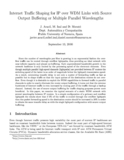Mostrar el registro sencillo del ítem
Internet traffic shaping for IP over WDM links with source output buffering or multiple parallel wavelengths
| dc.creator | Aracil Rico, Javier | es_ES |
| dc.creator | Izal Azcárate, Mikel | es_ES |
| dc.creator | Morató Osés, Daniel | es_ES |
| dc.date.accessioned | 2016-08-30T09:14:36Z | |
| dc.date.available | 2016-08-30T09:14:36Z | |
| dc.date.issued | 2001 | |
| dc.identifier.issn | 1388-6916 (Print) | |
| dc.identifier.issn | 1572-8161 (Electronic) | |
| dc.identifier.uri | https://hdl.handle.net/2454/21602 | |
| dc.description.abstract | Since the number of wavelengths per fiber is growing in an exponential fashion the over- flow traffic can be routed through overflow lightpaths, thus providing an ideal network with near-infinite capacity and almost no-buffering. Such unprecedented bandwidth growth in the network backbone is only limited by the processing speed of the electronic elements. Even though multiple parallel high-speed channels (lightpaths) are provided between IP routers the switching speed of the latter is an order of magnitude below the lightpath transmission speed. As a result, minimizing transfer delay is not only a matter of forwarding traffic as fast as possible but to shape traffic so that the input queues of the destination routers do not over-flow. Even though it is desirable to exploit the WDM capabilities to forward traffic in parallel channels in order to nearly eliminate the router output buffering, it turns out that the extreme burstiness of Internet traffic is even increased by routing part of the traffic through a backup channel. Instead, the use of source output buffering for traffic shaping purposes proves more beneficial. In this paper, we examine the typical scenario of a static WDM network with several wavelengths between IP routers. In a simple configuration of a primary and over flow lightpath the results show that if 3% of the traffic is routed through the over flow lightpath then the packet forwarding speed in the destination router should be increased in 20% in order to obtain the same transfer delay as with the single lightpath configuration with source output buffering. | en |
| dc.format.mimetype | application/pdf | en |
| dc.language.iso | eng | en |
| dc.publisher | Kluwer Academic Publishers | en |
| dc.relation.ispartof | Optical Networks Magazine, January/February 2001, n. 1, vol. 2, pp. 61-68 | en |
| dc.rights | © Kluwer Academic Publishers 2001 | en |
| dc.subject | Internet traffic | en |
| dc.subject | IP routers | en |
| dc.subject | WPM | en |
| dc.subject | Source output buffering | en |
| dc.subject | Multiple parallel wavelength | en |
| dc.title | Internet traffic shaping for IP over WDM links with source output buffering or multiple parallel wavelengths | en |
| dc.type | info:eu-repo/semantics/article | en |
| dc.type | Artículo / Artikulua | es |
| dc.contributor.department | Automática y Computación | es_ES |
| dc.contributor.department | Automatika eta Konputazioa | eu |
| dc.rights.accessRights | info:eu-repo/semantics/openAccess | en |
| dc.rights.accessRights | Acceso abierto / Sarbide irekia | es |
| dc.identifier.doi | 10.1023/A:1017267230889 | |
| dc.relation.publisherversion | https://dx.doi.org/10.1023/A:1017267230889 | |
| dc.type.version | info:eu-repo/semantics/acceptedVersion | en |
| dc.type.version | Versión aceptada / Onetsi den bertsioa | es |


